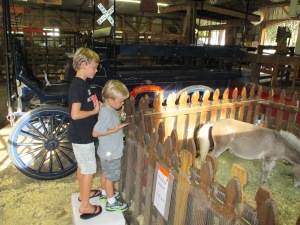After leaving Fort Sumter, we decided to drive over to see Charles Pinckney’s house to get a stamp for our Passport book. Only 28 acres of Charles Pinckey’s 715-acre Snee Farm plantation remains undeveloped. The Friends of Historic Snee Farm, Inc. saved the property from developers and donated it to the National Park Service. Charles Pinckney National Historic Site, SC.
Charles Pinckney was a member of an important low country family. He began his government career at the young age of 22 and retired at 64. Pinckney is considered one of our country’s Founding Fathers. Some of his accomplishments include: Militia officer during the Revolutionary War, Representative to State and National Legislators, Four-term government to South Carolina, Author of parts of the U.S. Constitution, Ambassador to Spain for 5 years.
Another thing that we learned about was the Gullah culture. The Gullah are a distinctive group of Black Americans from South Carolina and Georgia in the southeastern United States. There are roughly a half a million still living in small farming and fishing communities along the Atlantic coastal plain and on the chain of Sea Islands which runs parallel to the coast. Because of their geographical isolation and strong community life, the Gullah have been able to preserve more of their African cultural heritage than any other group of Black Americans. They speak a creole language similar to Sierra Leone Krio, use African names, tell African folktales, make African-style handicrafts such as baskets and carved walking sticks, and enjoy a rich cuisine based primarily on rice.
During the 1700s the American colonists in South Carolina and Georgia discovered that rice would grow well in the moist, semitropical country bordering their coastline. But the American colonists had no experience with the cultivation of rice, and they needed African slaves who knew how to plant, harvest, and process this difficult crop. The white plantation owners purchased slaves from various parts of Africa, but they greatly preferred slaves from what they called the “Rice Coast” or “Windward Coast” West Africa. The plantation owners were willing to pay higher prices for slaves from this area, and Africans from the Rice Coast were almost certainly the largest group of slaves imported into South Carolina and Georgia during the 18th century.
For the rest of the day we headed over to downtown Charleston, the French Quarter, and the Battery. We parked off of Meeting and just wandered through the streets looking at all different kinds of shops and the outdoor market.
For dinner we ate at Henry’s across from the market and no trip to Charleston is complete without an order of shrimp and grits. Davy loved the shrimp and grits and this is when he declares to me that he just loves trying new foods. He picked up a puzzle box and we stopped for some ice cream before going on our carriage ride.
Our carriage ride was a ghost tour and here is one of Davy’s favorite stories from the ride.
Philadelphia alley (AKA “Dueler’s Alley). Tucked away just off Market Street, running between Cumberland and Queen Streets in the beautiful French Quarter, lies Philadelphia Alley, ca. 1766. This alley has a high brick wall running down both sides meaning there would be less bystander casualties, so it is believed that this is the reason it was chosen for the dueling. Dr. Ladd and Ralph Isaacs were friends, and after several disputes including one over a woman and then an article printed in the paper Dr. Lad fearing he would be labeled cowardly and that his reputation would suffer challenged Ralph Isaacs to a duel. If not for himself, then he must defend the honor of Perdita, the young doctor reasoned. Steeling his resolve, he whistled on his way to meet his rival with pistols at dawn.
They pair of duelists met in the misty morning light of Philadelphia Alley. Intending on letting the challenge blow over, Dr. Ladd fired his pistol into the air, a way to save face. Ralph Isaacs meant to fire into Dr. Ladd’s leg, intending only on a slight wound to embarrass the doctor, but the pistol ball fired erratically and struck Dr. Ladd in the stomach. The physician was taken by gurney to his boarding house on Church Street. He died of the wound ten days later.
It is said that Philadelphia Alley still carries the sounds of pistol shots, the smell of gunsmoke, and the eloquent trill of Dr. Joseph Ladd’s whistling on his way into the alleyway that fateful morning. Ghostly visions of ladies in gowns appear on photographs, as do shadows and violet fire. Some experience time loops. Considered to be the most haunted lane in Charleston, there are rumors of over thirty recorded deaths.
Davy also liked the story of Blackbeard’s 30 men being hung in the battery and left for 6 weeks to warn off any who were thinking about piracy and the story of the man who took a photo on film of St. Philip’s cemetery in 1987 and after having developed his pictures discovered this ghost of a woman grieving over her stillborn child’s grave.
Last night here….off to North Carolina next!







































I love the tree photos!!!!